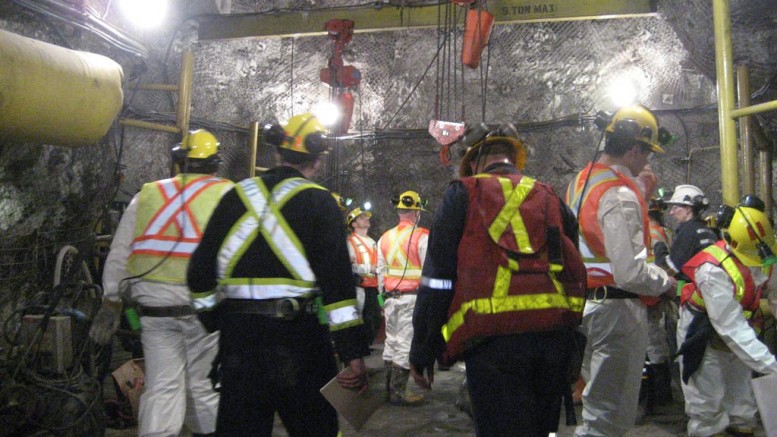[caption id="attachment_1003742740" align="aligncenter" width="550"]
 Macassa complex Credit: Kirkland Lake Gold
Macassa complex Credit: Kirkland Lake Gold[/caption]
The latest drill results from
Kirkland Lake Gold’s Macassa mine in Ontario include ‘exceptional’ gold grades and suggest potential for resource and reserve additions in three areas of the underground mine.
The 135 drillholes reported are from the south margin of the South Mine Complex (SMC), the Lower SMC area (LSMC), and the Amalgamated zone.
The producing SMC returned some of the highest gold grades outlined in the release. Highlight intercepts from this area include 14.5 metres of 253.7 g/t gold and 4.1 metres of 101.1 g/t gold. The miner’s latest interpretation of this part of the mine indicates an intersection of the SMC area with zones surrounding the Amalgamated unit, creating a broad zone of alteration with several high-grade structures, which remain open to the west and at depth.
Notable assay results from the LSMC include 2.4 metres of 103.3 g/t gold; and 2.2 metres of 58.9 g/t gold. These intercepts are from holes targeting existing inferred resources and areas with gaps in drilling around the upper west part of this zone.
Assays from drilling around existing resources within the Amalgamated zone include 8.2 metres of 210.4 g/t gold and 2 metres of 52.9 g/t gold. According to the release, large areas remain untested along strike and down dip of the existing mineralization within the Amalgamated unit.
“Today’s results are encouraging as they support our view that there is substantial exploration potential in areas where the dip of the SMC approaches the contact with mineralized zones stacked vertically along the Amalgamated Break,” Tony Makuch, Kirkland Lake’s president and CEO, said in a release. “These are separate areas of gold mineralization coming together, which is very interesting, and what we are seeing are some extremely high-grade intersections.”
Makuch also added that these latest results also suggest new mineralization within the LSMC and along the Amalgamated Break, “further increasing our confidence that there are new mineral reserves to be discovered as we drill along the Break through the Kirkland Lake camp.”
The Macassa mine is in Kirkland Lake, 580 km north of Toronto, and began production in 1933. Kirkland Lake Gold restarted the mine in 2002 after the previous operator suspended operations in 1999.
Current production is hoisted to surface through the #3 shaft. The miner is working to sink a new shaft at the site, to support higher production levels at lower costs. This project is expected to be completed by the end of 2023. Kirkland Lake Gold is looking to increase production at Macassa to 400,000 oz. per year over the next five to seven years.
This year, the mine is expected to churn out around 200,000 oz. of gold.
Brian Quast of BMO Capital Markets noted that the latest results underscore the continuation of organic growth at the company. “Kirkland Lake reported similarly positive drills results in April 2020, including identifying a new corridor along the Main Break,” Quast wrote in a note to clients. “The more recent results, which focus on the SMC and the Amalgamated Break, demonstrate Kirkland Lake’s consistent exploration success at Macassa.”
The mining analyst also said he believes more is likely to follow. “We anticipate that the pace of exploration will increase after the commissioning of the Shaft #4, and while today’s results are positive, we expect more significant reserve/resource growth after some of these high-grade areas begin to be accessed from Shaft #4.”
For more information, visit
www.KL.Gold.

 Macassa complex Credit: Kirkland Lake Gold[/caption]
The latest drill results from Kirkland Lake Gold’s Macassa mine in Ontario include ‘exceptional’ gold grades and suggest potential for resource and reserve additions in three areas of the underground mine.
The 135 drillholes reported are from the south margin of the South Mine Complex (SMC), the Lower SMC area (LSMC), and the Amalgamated zone.
The producing SMC returned some of the highest gold grades outlined in the release. Highlight intercepts from this area include 14.5 metres of 253.7 g/t gold and 4.1 metres of 101.1 g/t gold. The miner’s latest interpretation of this part of the mine indicates an intersection of the SMC area with zones surrounding the Amalgamated unit, creating a broad zone of alteration with several high-grade structures, which remain open to the west and at depth.
Notable assay results from the LSMC include 2.4 metres of 103.3 g/t gold; and 2.2 metres of 58.9 g/t gold. These intercepts are from holes targeting existing inferred resources and areas with gaps in drilling around the upper west part of this zone.
Assays from drilling around existing resources within the Amalgamated zone include 8.2 metres of 210.4 g/t gold and 2 metres of 52.9 g/t gold. According to the release, large areas remain untested along strike and down dip of the existing mineralization within the Amalgamated unit.
“Today’s results are encouraging as they support our view that there is substantial exploration potential in areas where the dip of the SMC approaches the contact with mineralized zones stacked vertically along the Amalgamated Break,” Tony Makuch, Kirkland Lake’s president and CEO, said in a release. “These are separate areas of gold mineralization coming together, which is very interesting, and what we are seeing are some extremely high-grade intersections.”
Makuch also added that these latest results also suggest new mineralization within the LSMC and along the Amalgamated Break, “further increasing our confidence that there are new mineral reserves to be discovered as we drill along the Break through the Kirkland Lake camp.”
The Macassa mine is in Kirkland Lake, 580 km north of Toronto, and began production in 1933. Kirkland Lake Gold restarted the mine in 2002 after the previous operator suspended operations in 1999.
Current production is hoisted to surface through the #3 shaft. The miner is working to sink a new shaft at the site, to support higher production levels at lower costs. This project is expected to be completed by the end of 2023. Kirkland Lake Gold is looking to increase production at Macassa to 400,000 oz. per year over the next five to seven years.
This year, the mine is expected to churn out around 200,000 oz. of gold.
Macassa complex Credit: Kirkland Lake Gold[/caption]
The latest drill results from Kirkland Lake Gold’s Macassa mine in Ontario include ‘exceptional’ gold grades and suggest potential for resource and reserve additions in three areas of the underground mine.
The 135 drillholes reported are from the south margin of the South Mine Complex (SMC), the Lower SMC area (LSMC), and the Amalgamated zone.
The producing SMC returned some of the highest gold grades outlined in the release. Highlight intercepts from this area include 14.5 metres of 253.7 g/t gold and 4.1 metres of 101.1 g/t gold. The miner’s latest interpretation of this part of the mine indicates an intersection of the SMC area with zones surrounding the Amalgamated unit, creating a broad zone of alteration with several high-grade structures, which remain open to the west and at depth.
Notable assay results from the LSMC include 2.4 metres of 103.3 g/t gold; and 2.2 metres of 58.9 g/t gold. These intercepts are from holes targeting existing inferred resources and areas with gaps in drilling around the upper west part of this zone.
Assays from drilling around existing resources within the Amalgamated zone include 8.2 metres of 210.4 g/t gold and 2 metres of 52.9 g/t gold. According to the release, large areas remain untested along strike and down dip of the existing mineralization within the Amalgamated unit.
“Today’s results are encouraging as they support our view that there is substantial exploration potential in areas where the dip of the SMC approaches the contact with mineralized zones stacked vertically along the Amalgamated Break,” Tony Makuch, Kirkland Lake’s president and CEO, said in a release. “These are separate areas of gold mineralization coming together, which is very interesting, and what we are seeing are some extremely high-grade intersections.”
Makuch also added that these latest results also suggest new mineralization within the LSMC and along the Amalgamated Break, “further increasing our confidence that there are new mineral reserves to be discovered as we drill along the Break through the Kirkland Lake camp.”
The Macassa mine is in Kirkland Lake, 580 km north of Toronto, and began production in 1933. Kirkland Lake Gold restarted the mine in 2002 after the previous operator suspended operations in 1999.
Current production is hoisted to surface through the #3 shaft. The miner is working to sink a new shaft at the site, to support higher production levels at lower costs. This project is expected to be completed by the end of 2023. Kirkland Lake Gold is looking to increase production at Macassa to 400,000 oz. per year over the next five to seven years.
This year, the mine is expected to churn out around 200,000 oz. of gold.





Comments